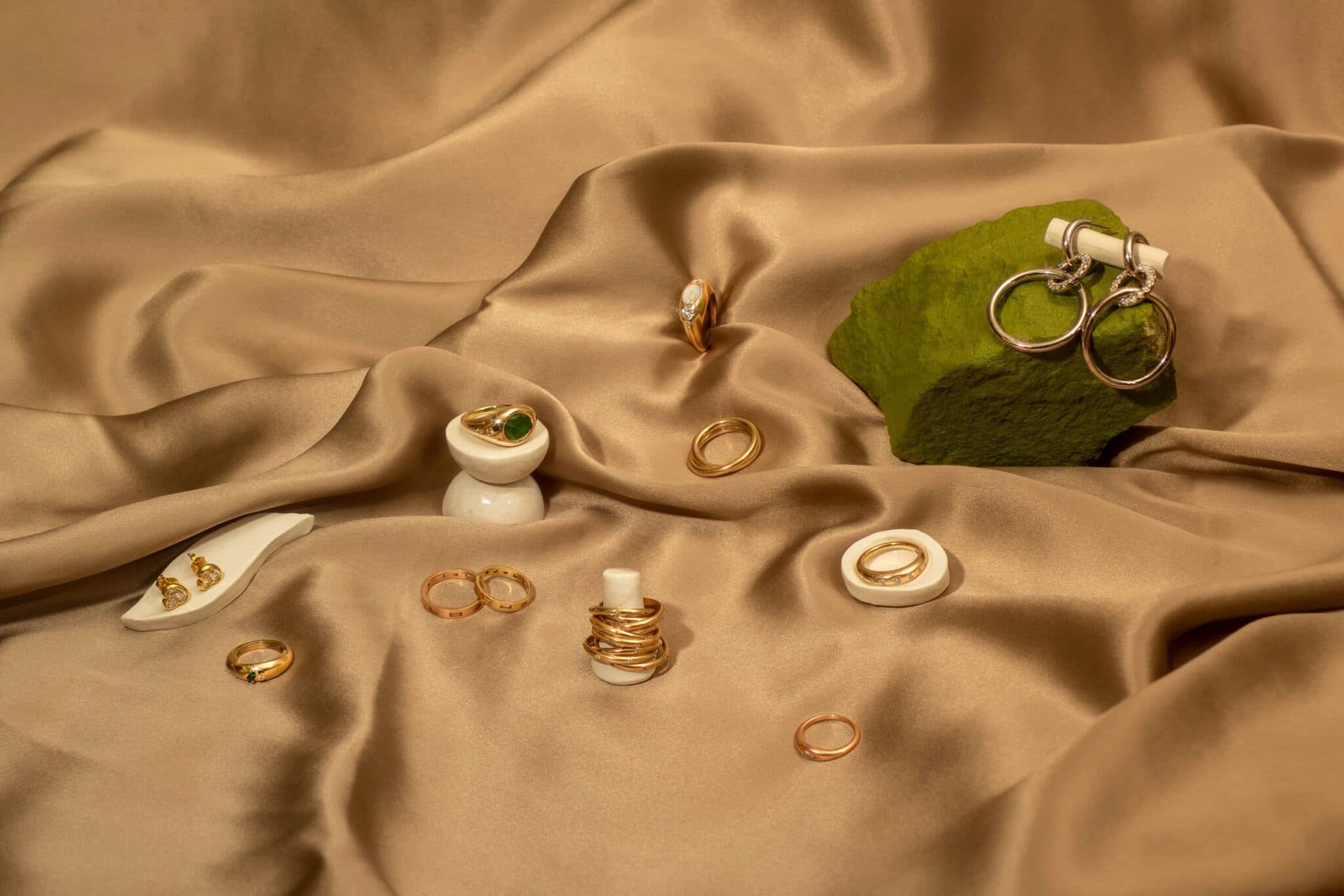How do you make young people care about old things? Hine Fine Jewelry, the jewelry studio founded by gemologist Rachael Bennett, starts with a proposition: Bring me grandma’s jewels. Bennett’s practice—which specializes in taking precious stones from family heirlooms, repolishing and updating them into something more wearable and modern—represents upcycling at its most luxurious. There’s no prerequisite for fine hand-me-downs, though: She’ll gladly give a second life to a singleton earring missing its sibling, a stone from a ring whose setting feels outdated, or an antique brooch that hasn’t seen the light of day in decades.
The signature Hine style that first won me over was a rounded band embedded with a client’s gemstones—Bennett gleaned her inspiration for its slightly bulbous silhouette from the shape of Prada’s puffy headbands. She found another unlikely muse on a visit to Florence, Italy: “I loved seeing these seeing super thin passageways where it looked like the [buildings] were touching, even though they weren’t, and there was just a little tiny bit of light coming through.” Bennett credits this visual phenomenon as the reference for another favorite ring of hers, a band with two sides that nearly meet at the front but stay perpetually suspended apart.

Bennett transformed a collection of vintage gem-set rings into a single wraparound band.
Hine Fine Jewelry
A client’s mother’s marquise diamond band became a one-of-a-kind wavy ring.
Hine Fine JewelryWhile Bennett works on all sorts of projects (her favorite assignments being big, exuberant cocktail rings), she has become the first call for many in the market for an engagement ring. There’s an element of conflict resolution inherent in the Hine methodology, a quality especially prized in all things wedding- and marriage-related. Often, a parent or grandparent will suggest a family heirloom for an upcoming betrothal, but the couple doesn’t consider it quite what they had in mind. By reworking the gems, Hine offers an elegant escape hatch when the only options seem like acquiescing to or rejecting the family stone.
Hine is part of a rapidly developing ecosystem of fine jewelry repurposing, one that Victoria Lampley, a jewelry consultant and founder of the Stax Advisory, has witnessed firsthand with her own clientele. “A lot of our clients come to us for sentimental projects, and this can often involve resetting stones from loved ones who have passed,” Lampley explains. “I’m a big advocate for repurposing and always aim to add personal touches, not always visible to the naked eye, to each piece we rework.” At the moment, her shortlist of custom jewelers who specialize in such resets includes Jenna Katz, RENNA, Maggi Simpkins, Alice Cicolini, and Rebecca Pinto. Other practitioners making a name for taking on such collaborative projects includes Isabel Borland of Kinderhook, New York, whose hand-carved and hand-finished pieces take on an otherworldly quality, and Maine-based Kate Jones of Ursa Major, distinguished for her oblong Pilar rings.
-

A brushed-gold dome ring by Jenna Katz.
Jenna Katz Fine Jewelry -

A sapphire ring designed by Rebecca Pinto.
Rebecca Pinto Jewelry
Kelsey Lim, the designer behind Abel Objects, has noticed a similar uptick in custom projects repurposing family heirlooms since starting her professional jewelry practice five years ago. “It makes sense to me as people are becoming more intentional as consumers across all industries, and thinking more about the environmental and social impact of their purchases,” Lim says. “There’s also something quite priceless about having a stone with a story, and a piece that is truly one-of-a-kind in an ecosystem of mass-produced goods.”
Lim and her cousins recently inherited a few pieces of jewelry from their grandmother, including a gold solitaire ring featuring a two-carat brilliant cut diamond. After deciding that the ring should go to Lim’s cousin who was planning a proposal, Lim began re-envisioning the ring for its new owners. The original ring had a high cathedral setting, which felt outdated and a bit too flashy for the bride-to-be’s taste, so Lim opted to set the stone lower in the new ring and simplified the band to a more modern knife-edge.

Abel Objects founder Kelsey Lim redesigned her grandmother’s solitaire ring for her cousin with a lower, knife-edge setting.
Abel Objects“The approach I took was not unlike my approach to any piece of jewelry I make: My aim is always to create pieces that are simultaneously modern and timeless—walking the fine line between classic-slash-boring and interesting-slash-trendy,” Lim explains. Working only in solid gold and silver—materials that ensure her jewelry stands the test of time, not only in style but in substance—Lim designs with a hunch that history might someday repeat itself: “The intention and hope is that one day, the pieces I create might be passed down again—whether kept as-is or reimagined into something for the next generation.”
Amidst a greater repurposing movement, the practice provokes a familiar question: When is updating an older or antique piece sensible, when is it sacrilegious, and how do you make that call? This dilemma doesn’t weigh on Bennett: “My whole philosophy is just that these pieces are supposed to be worn—not kept in a box,” she says. “People don’t come to me with pieces that they wear, they come with the pieces they don’t wear, and I’m like, ‘Your grandma would want you to wear this.’ I feel like I’m helping the stone have a new life.”




















